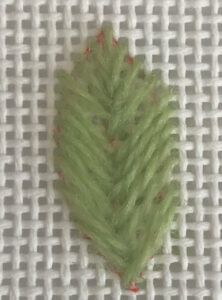When stitching a needlepoint canvas you get results in a couple of a ways.
Sometimes threads do the trick, or a mix of threads with different densities.
Sometimes stitches do the heavy lifting.
Often you will have a canvas that has details going in different directions such as in the Sunday Hats to the right, or Fox in Birch Trees by Two Can Art below.


You can stitch with continental or basketweave or change some areas to stitches that provide some visual interest and work with the direction better – the sky goes across and the trees up and down. There are lots of stitches and you only need think of one area and a great choice for that area.
Today we will showcase stitches that can be used in almost any area and a couple that provide a great result for specific details. Any of these stitches can be found in a google search by the name of the stitch and shown in videos of how to do them. We also have them diagramed in pdf format that can be emailed.

Heringbone
GREAT FOR: Backgrounds, Animals (best for one color), Clothes, Foliage, Birds, Buildings
This stitch creates movement – paths, skies, snow expanse come to mind

Cashmere
Cashmere is a universal stitch. Think of the Cashmere unit as a group of 1 continetal, 2 long stitches over 2 intersections and then another Continental. By using this train of thought, you can work the stitch either horizontally or vertically. No matter which way you stitch Cashmere, the end result will be the same.

Split Stitch
Have a thin tree trunk such as the fox laptop image above or other up and down lines? Perfect. Consider blending two colors with this stitch for trunks that aren’t solid such as the fox in snow above or change the color as you go.

Fish Bone Stitch
While we are looking for small stitches that create great texture and are easy to do. let’s talk about the Fish Bone. A wonderful fill for certain areas that you might want to use satin stitch for but it handles curves much better. It is also a great stitch for shading. Commonly used for leaves and feathers, but can be applied to many details.
